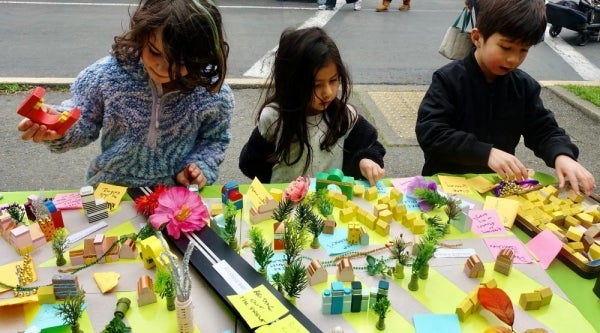Inclusive Engagement Techniques and Approaches
Project Models

What is it?
Project models are three-dimensional representations that serve as tools to help the public visualize and interact with project concepts. They can come in the form of miniature objects representing buildings or public spaces, real-world installations of pilot projects or digital interactive models. Often, project models are scaled down to fit on a tabletop or small area but can also be built at full scale to make project concepts more realistic.
When to use it
Project models support hands-on collaboration and can help provide initial demonstrations of concepts. They can help participants visualize a project’s scale, relationships between buildings and spaces and design elements. Project models can also foster creativity and collaboration when participants help build them using physical materials or digital tools. Models can also effectively demonstrate potential impacts and trade-offs.
How to do it
Before
- Reflect on the ideal way for the public to engage with the project model to support public participation goals.
- Select the desired model area and the scale at which it should be portrayed. The model should be visible and understandable for participants.
- Consider what is around the project area, such as existing buildings and places or other upcoming projects. Provide context by showing the project model within its neighborhood/surroundings to give participants an idea of future changes.
- Create an informal draft or virtual mockup of the project model to evaluate its scale and the area it will represent.
- Determine whether participants can interact with the model, change its components, move pieces, or solely observe.
- For physical models:
- Plan how the model will be transported to the display location(s).
- Identify dimensions, heights, and other required measurements.
- Choose a digital platform if creating a virtual project model. These are computer-generated models that use technology to create detailed, interactive project representations. There are several ways to use technology for virtual project models:
- Rendering: The process of finalizing digital images or 3D models with lighting, shadows and textures to visualize a project's outcome.
- Virtual Reality (VR) / Augmented Reality (AR): Interactive technologies that immerse users in a virtual world (VR) or overlay digital content onto the real world (AR) using cameras, sensors and displays.
- For participant-built models, prepare simple components like blocks, templates or pre-cut pieces.
- Obtain any necessary approvals if considering a project model on private property. Project models of a large scale in the public right-of-way may require a special event permit.
During
- Provide any background materials using clear, simple and inclusive language and orient participants on how to engage with the model.
- Assemble the model as needed using pre-determined dimensions and drafts.
- Offer multiple ways for participants to share their perspectives such as through surveys or guided discussions.
- Take pictures of the model for future reference.
After
- Compile, digitize and analyze public input to inform project decision-making.
- Consider maintaining or updating the model as the project evolves.
Resource considerations
![]()
Cost: Minimal to High
Cost can vary significantly depending on the size and scope of the model. While simpler models can be low-cost, more complex and detailed models can be considerably more expensive.
![]()
Time: Moderate to High
Smaller, simpler models can be produced in about one month, while intricate models with details may take up to one year. Models that demonstrate a 1:1 scale may require additional approvals and time to construct.
![]()
Capacity: Minimal to High
While simple models may take only one or two staff to support, more complex models may require a full team including designers, facilitators and technical experts.
Other considerations
- Project models can work well when combined with other engagement techniques such as pop-up events, workshops and TV/radio/podcast interviews.
- Colorful paint, movable furniture and temporary structures can be used for full scale models to show future changes to public spaces and create flexible areas for public engagement. For full scale models in the public right-of-way, contact the asset-managing department (the department that manages the specific type of asset such as Transportation, or Parks and Recreation, etc.) and determine if any permits are needed.
How to make it more inclusive
- Choose materials that are safe for handling. If a physical model is interactive, use non-toxic materials and avoid small pieces that could pose a hazard for children.
- Identify any language access needs in advance and consider providing participation support.
Inclusive Engagement Techniques and Approaches
- Introduction
- Appreciative Inquiry
- Arts-based Engagement
- Briefings
- Comment Forms
- Community Cafés
- Community Mapping
- Community Office Hours
- Email Notifications
- Engagement through Service
- Fact Sheets
- Flyers
- Focus Groups
- Game-based Approaches
- Hotlines
- Information Kiosks
- Interviews
- Meeting in a Box
- Mobile Engagement
- News Releases
- Newsletters
- Open Houses
- Participation Support
- Pop-Up Events
- Project Models
- Project-specific Groups
- Public Meetings
- Public Service Announcements (PSAs)
- Social Media
- Surveys and Polls
- Tours and Field Trips
- TV/Radio/Podcast Interviews
- Vision Walls
- Web-Based/Hybrid Meetings
- Webpages
- Workshops


 Inclusive Public Engagement Guide
Inclusive Public Engagement Guide